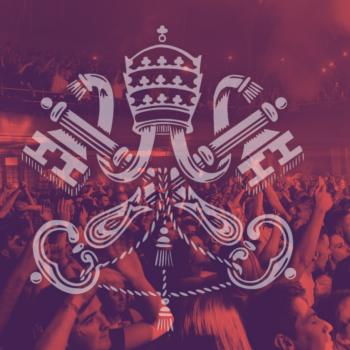The Power of Healing Through Forgiveness
Mark 2:1-12
The Power of Healing Through Forgiveness is a sermon from Mark 2:1-12 about the role of forgiveness in healing. The sermon shows three obstacles to healing and how a Christian can help provide healing through forgiveness.
In Windows on the Word, D. H. DeHaan tells the story of a little nine-year-old boy who was struggling to practice the piano. Having found out that Ignacy Jan Paderewski, the great pianist, was coming into town to do a concert, his mother bought a ticket for her son and another for herself. The day of the concert she dressed the boy in his little tuxedo and headed for the performance. She set him down in the chair next to her and began visiting with some friends seated close by. The little boy was mesmerized with all there was to see. His eyes combed the large concert hall and then locked in on a beautiful concert grand piano on display in the center of the stage. His eyes big with enthusiasm, he felt drawn to the massive, lustrous instrument. The nine-year-old got up out of his seat and walked down the aisle, heading straight for the piano. Excitedly he crossed the stage, sat down, and began playing “Chopsticks” on the handsome keys.
As the amateur pianist’s song began to echo through the great room, the spectators began to say, “Where’s … who is …?” “Hey, kid, stop!” “Where’s his parents?” When the mother glanced at the stage and saw her son in all his splendor, her face turned red from embarrassment.
Standing backstage, the man of the hour, Paderewski, heard the commotion. Without the boy seeing him he came out from behind the drawn curtain and approached the piano. Upon arrival, he reached his skilled hands around the boy and joined him, improvising a lovely refrain that perfectly blended with the little boy’s “Chopsticks.” The boy hesitated slightly, but Paderewski spoke with wholehearted approval, “Keep it up. Don’t stop. You are doing just fine.”
The grace of second chances extends an invitation to the people of God to encourage one another, for His grace is sufficient whether it needs to be applied to our weaknesses or to our sin. Even as the great Paderewski had the resources to come alongside this little one in his weakness, how much more reason do we have to come alongside each other as brothers and sisters in Christ.1
We will see tonight how four friends will come to help a man in need. An example of forgiveness and healing.
Mark, as we have learned, is the master of time gaps. Rather than getting bogged down in the details of Jesus’ restricted ministry in the wilderness, he skips forward to the re-entry into Capernaum. Last we saw Jesus, He left in triumph. Now He returns under suspicion. Evidently, the word of the cleansed leper who disobeyed orders precedes Jesus to Capernaum. When He heals the leper, He hopes that He can still serve the needs of man and stay within the system. That hope has vanished. All around Him are critical eyes squinting to find fault with every action and skeptical tongues wagging at the implications of every utterance. Jesus has no choice but to confront the system and challenge its dead orthodoxy.2
First, consider this scene through the eyes of the Lord Jesus.
HOW JESUS SAW THE SITUATION3
1. He looked up (Mark 2:1-5)
When He looked up, He saw the four men on the roof with their sick friend. Houses had flat roofs which were usually accessible by means of an outside stairway. It would not be difficult to remove the tiles, laths, and grass that comprised the roof and make an opening large enough to fit their friend through on his mat.
We must admire several characteristics of these men, qualities that ought to mark us as “fishers of men.” For one thing, they were deeply concerned about their friend and wanted to see him helped. They had the faith to believe that Jesus could and would meet his need. They did not simply “pray about it,” but they put some feet to their prayers; and they did not permit the difficult circumstances to discourage them. They worked together and dared to do something different, and Jesus rewarded their efforts. How easy it would have been for them to say, “Well, there is no sense trying to get to Jesus today! Maybe we can come back tomorrow.”
2. He looked down (Mark 2:5)
When our Lord looked down, He saw the palsied man lying on his mat; and immediately Jesus went to the heart of the man’s problem—sin. Not all sickness is caused by sin (see John 9:1–3), but evidently this man’s condition was the result of his disobedience to God. Even before He healed the man’s body, Jesus spoke peace to the man’s heart and announced that his sins were forgiven! Forgiveness is the greatest miracle that Jesus ever performs. It meets the greatest need; it costs the greatest price; and it brings the greatest blessing and the most lasting results.
3. He looked around (Mark 2:6-7)
Then Jesus looked around and saw the critics who had come to spy on Him (see Luke 5:17). These religious leaders certainly had every right to investigate the ministry of this new teacher, since the religious life of the nation was under their supervision (Deut. 13). But they should have come with open minds and hearts, seeking truth, instead of with critical minds, seeking heresy. Some of the negative attitude that had been present in Judea (John 4:1–4) had now invaded Galilee, and this was the beginning of the official opposition that ultimately led to our Lord’s arrest and death. He was now so popular that the Jewish leaders dared not ignore Him. In fact, they must have arrived early for the meeting, because they were right at the scene of action! Or perhaps Jesus graciously gave them front row seats.
4. He looked within (Mark 2:8)
When the Lord looked within, He saw the critical spirit in their hearts and knew that they were accusing Him of blasphemy. After all, only God can forgive sins; and Jesus had just told the paralytic that his sins were forgiven. Jesus was claiming to be God!
Two characteristics of a true servant is to forgive and heal. Forgiveness and healing perform the same function: they free a person to do what they need to do. Forgiveness is a relational freedom. Healing is physical and emotional freedom. True servants are in the healing business. Two parts of that healing business are relational healing (forgiveness) and physical healing. First, let’s deal with three obstacles to healing that we see in this text.
THREE OBSTACLES TO HEALING
1. Physical Obstacle – the sick man (Mark 2:1-4)
Here, we see that there were many people who wanted to see Jesus (Mark 2:2). The man himself could not come to see Jesus. He had to wait in line. Instead, He needed four friends to help him “break in line” (Mark 2:3-4).
We don’t know the illness that caused this man to be paralyzed. We only know that because of his condition of paralysis, he couldn’t walk. You know that there are many people, who for no fault of their own, can’t get the healing that they need. They need to lean on other people for help. There is this physical obstacle.
2. Philosophical Obstacle – Skepticism by religious people (Mark 2:6-7)
We also see that there is a philosophical obstacle. The religious leaders didn’t believe that Jesus could heal this person because they believed that only God could heal. We actually don’t know if this man sinned and if that sin caused his sickness. It is an assumption from the conversation in the text.
But Jesus, knows that the religious leaders were unwilling to help the man because of this belief. You know, we can be skeptical too. We can say to ourselves that a person doesn’t deserve to get healing. We can easily say that because a person is disabled, it is because they are full of sin. They are this way because of their choices in life.
What is Jesus’ answer to this skepticism? “I’ll heal him anyway.” “I’ll prove to you that I can heal the man by forgiving his sin.”
3. Personal Obstacle – Personal hesitation (Mark 2:5, Mark 2:10-11)
The sick man never speaks in this encounter. Yet, I suspect that he had personal hesitations. I think this because first, Jesus compliments the faith of the four friends. When a person is sick, they may hesitate to ask for healing. You know this. People need to go see the doctor. But for various reasons, they hesitate. “I’m not that bad.” “I’m not that sick.” The friends probably sensed that the sick person needed help, but wouldn’t ask for help. They took him in faith, knowing that the crowds would be large.
Notice that when the man meets Jesus, Jesus is in the midst of a theological argument. Can a man who was sick be forgiven? Can Jesus forgive a man who the religious leaders believed was sick due to sin? It’s as if Jesus sees the opportunity to one-up the religious leaders. He sees this man being lowered through the roof. Jesus takes the unique opportunity and decides to heal this man.
In other places, Jesus asked a person if they wanted to be healed. Here, Jesus just told the man that He would be healed:
“But so that you may know that the Son of Man has authority on earth to forgive sins”—he told the paralytic—“I tell you: get up, take your mat, and go home.”” (Mark 2:10–11, CSB)
Jesus has the authority to forgive sin, and proves it by healing a man without his permission. You know that you go to the hospital and they ask your permission to perform a procedure that could heal you. But there are risks and so they ask permission. Here, Jesus didn’t make the man sign a waiver. He didn’t ask for the man’s permission. He just healed Him. He forgave his sin and then proved the forgiveness by healing the man’s illness.
This probably proves that the man’s paralysis was related to sin. Jesus was making the clear claim that He was God. This brings me to the two themes in this section: forgiveness and physical healing.
THEME: RELATIONAL HEALING – FORGIVENESS
Christians should be in the relational healing business. The problem with the religious people in Jesus’ day is they depended so much on the religious system that they forgot the importance of forgiveness. The leaders forgot the power of forgiveness. They assumed that only God could forgive. Yet Jesus taught that everyone can learn to forgive. God forgives my sin. But I forgive other people when they sin against me. Jesus modeled that for us in His Prayer. He also modeled it for us in His Life.
THEME: PHYSICAL HEALING
When Jesus healed the paralytic and proclaimed, “Son, your sins are forgiven,” he was indicating the connection between the disease (felt need) and the deeper sickness (guilt and shame that require forgiveness). To heal the body without dealing with the underlying spiritual issue of forgiveness would have left the paralytic still in need of healing. Imagine that you have a daughter who is running a high fever. She complains of chills, so you cover her with blankets until she feels warm. If you ignore the cause of the fever, have you really helped her? Jesus understood that the man’s deepest need was spiritual, and he responded to both the physical and the spiritual need.4
He used this opportunity to teach a paralyzed man and the people around him that the ultimate priority of his coming was not to relieve suffering, as important as that is. Instead, his ultimate priority was to sever the root of suffering: sin itself.5
Physical healing is linked to relational healing. We know this because the contravention is true: Relational ailments can cause physical ailments. Relational stress can cause emotional stress that can lead to physical stress. God can bring about physical healing. But so can we. When we relate to others with the power of forgiveness, it can actually improve a person’s mood. It can actually help a person heal. This is why prayer for healing is so important. When I pray for someone else, I am impacting the physical healing of someone else. This is what the four men were doing. Do you think that they just decided to pick the man up on a whim? No, they had been praying for the man’s healing. They saw that Jesus heals people and so they took this man in faith. They were willing to drop him down through the roof.
Let me share with you this story.
Sometimes Sally carries me. At other times, Rhonda is my transport. Sandy has been known to lift me up. And I could name a few others who have borne my weight over the years.
We all get paralyzed at times. Although we may not be physically paralyzed like the man in this Scripture, we may be emotionally or even spiritually unable to move like we should. Fears, worries, weariness, discouragement… all these things can impede our mobility.
But that doesn’t have to mean we’re finished.
That’s one of the reasons God gives us friends. Through their words, prayers, and encouragement, they keep us going when we feel we can’t move. They can even take us to Jesus when we feel spiritually paralyzed.
And in return, we can do the same for others. Do you know someone who needs a little help walking? Or maybe who can’t see Jesus because of the crowds of people or concerns in his or her life? Maybe it’s time to carry a friend to Jesus.6
1 Charles Swindoll, Swindoll’s Ultimate Book of Illustrations and Quotes (Nashville, TN: Thomas Nelson, Inc., 1998), 178. In Elizabeth Ward, Can I Get a Do-over? The Grace of Second Chances (Uhrichsville, OH: Barbour, 2012).
2 David L. McKenna and Lloyd J. Ogilvie, Mark, vol. 25, The Preacher’s Commentary Series (Nashville, TN: Thomas Nelson Inc, 1982), 57.
3 Warren W. Wiersbe, The Bible Exposition Commentary, vol. 1 (Wheaton, IL: Victor Books, 1996), 115.
4 Grant R. Osborne, Mark, ed. Mark L. Strauss and John H. Walton, Teach the Text Commentary Series (Grand Rapids, MI: Baker Books, 2014), 41.
5 David Platt, Because We Are Called to Counter Culture: How We Are to Respond to Poverty, Same-Sex Marriage, Racism, Sex Slavery, Immigration, Persecution. Abortion, Orphans, and Pornography (Carol Stream, IL: Tyndale, 2015).
6 Gary Chapman and James Stuart Bell, Love Is a Verb Devotional: 365 Daily Inspirations to Bring Love Alive (Grand Rapids, MI: Baker, 2011).
Photo by KEEM IBARRA on Unsplash
Other Posts:

















